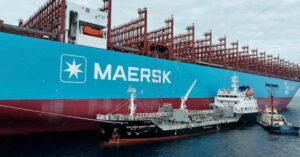
U.S Navy To Use Swarms of Marine Drones For Preventing Chinese Invasion of Taiwan
February 3, 2024
IMO Unveils Four-Year Agenda For Safer And Greener Shipping
February 5, 2024
The world’s first ship-to-ship (STS) bunkering of green methanol for the 16,200 TEU container ship Ane Maersk was accomplished at Ulsan Port in South Korea. The Ulsan Port Authority and the Korean Ministry of Oceans and Fisheries supervised the operation, a significant step in the worldwide maritime industry’s shift to sustainable fuels.
The Ministry of Oceans and Fisheries had already laid the necessary institutional foundation, such as the “Guidelines for Approval of Self-Safety Management Plan for Methanol Supply,” before this significant event. Essential knowledge was gathered through two methanol supply trials with the Ulsan Port Authority in July and November of the previous year.
The Minister of Oceans and Fisheries, Kang Do-Hyung, highlighted how foreign ports are increasingly competing to be the first to supply sustainable marine fuel. He highlighted the global shipping industry’s overarching objective of reaching net-zero emissions by 2050 and also committed to all-out efforts to boost Korea’s competitiveness and establish the country as a pioneer in the transition to sustainable fuels.

Ulsan Port Authority President Kim Jae-gyun vowed to adjust to the paradigm shift in ship fuel proactively. Building on the success of the world’s first green methanol ship-to-ship bunkering for container ships in July of the previous year, he believed Ulsan Port would become a sustainable marine fuel supply centre.
Maersk’s Ane is the first of eighteen massive container ships ordered by the Danish shipping company, fueled by methanol, and was involved in the historic bunkering operation. The ship bearing the name of Ane Maersk Mc-Kinney Uggla, the Chair of the AP Moller Foundation and AP Moller Holding, will be utilised on Maersk’s AE7 route connecting Asia and Europe.
According to Maersk, “green fuels” are defined as having either very low (80–95%) or low greenhouse gas (GHG) emissions (65–80% life cycle GHG reductions compared to fossil fuels) GHG emissions. The CEO of AP Moller-Maersk, Vincent Clerc, expressed confidence that this fleet of methanol-powered ships would substantially contribute to the company’s lofty climate targets.
One of Ane Maersk’s distinctive features is the accommodation block and bridge’s front positioning, which improves fuel-efficient operations. Although using methanol to power container ships is becoming more common, there are still issues with the restricted supply of blue or green methanol for fuel use. Maersk is committed to obtaining sustainable fuels for its ships by 2024 and 2025, having pioneered this cutting-edge strategy.
Reference: Seatrade Maritime, Marinelink
World’s First Ship-To-Ship Green Methanol Bunkering For Container Ship Ane Maersk Successful appeared first on Marine Insight – The Maritime Industry Guide
Source: Maritime Shipping News


